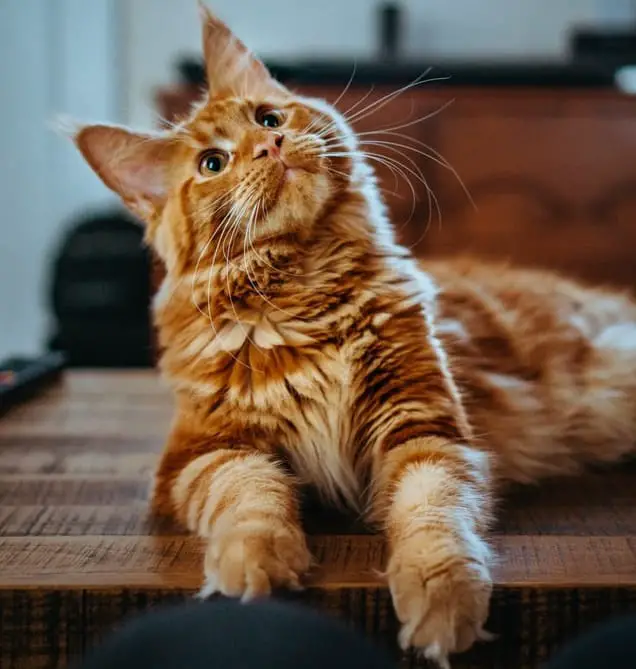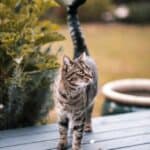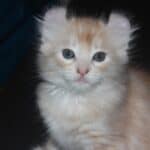
In recent years, cat enthusiasts have been fascinated by the beauty and the proud and wild aspect, elegant and stealthy like their movements, of free-born felines; it is for this reason that breeds of domestic cats very reminiscent of wild species were created, such as the Pixiebob or the Bengal .
The American Bobtail cat also enters this new group, with one difference: the birth of this cat is due more to chance than to human imagination, even if subsequently, to better define and fix its characteristics, we had to resort to genetic selection. Its appearance is reminiscent of a small lynx covered with its winter fur, but its very good character, soft and placid, makes it very sociable with all, human beings as animals, placing it rightly in the category of domestic cats. .
The origins of the American Bobtail cat
In the United States, in the late seventies, the Sanders were vacationing in Arizona, near an Indian reservation when one day, during a walk, they found a brown spotted tabby kitten. whose tail was very strange: it was short, in the shape of a pompom and folded over the back.
Intrigued and fascinated by his curious appearance but also by his intelligence and vivacity, they brought him back to their farm in Iowa, where this impetuous cat succeeded in covering the Siamese seal point of the house before the castration that had been planned for it. A litter of black tabby striped kittens was born, with either long or daddy-like tails; some were donated, others went to live in the attics where, one fine day, a big cream point cat of the Siamese category passed by chance but with white feet.
The result of his meeting with the damsels of the litter was truly fascinating: kittens with blue eyes, short tails, bearing the marks of the Siamese but with white feet. A neighbor, Mendy Schultz, began with them a breeding and selection program to create a new breed, also crossing some colorpoint Persians to lengthen the coat. The new breed was definitely developed by the Black sisters. These succeeded in eliminating the Manx gene (the one that causes anuria), which had undoubtedly been introduced to speed up selection, also brought Maine Coon blood to strengthen the potency and strength of the morphological structure and, in 1989, the TICA (The International Cat Association) accepted in provisional class the American Bobtail cat .
The ideal cat
They are medium to large in size, with strong bones, and males can weigh 6 to 9 kg without being too fat because their musculature is still well developed. Their head is broad, the cheeks strong, without flat areas and their muzzle slightly wider than long, in the shape of a rounded triangle. Their chin is strong and well developed; their profile shows a slight recess between the eyes.
The ears are medium and set fairly low on the head, well open, with slightly rounded tips which bear at their top a small tuft of hair reminiscent of that of the lynx known as lynxtip. The eyes are vaguely almond shaped, slightly sloping and very large; their color must harmonize with that of the dress. For colourpoint, they must always be blue.
The chest is broad, rounded and powerful, the back slightly arched. The legs are medium in size but not in proportion to the body, making them appear short, with strong and well-developed bone structure; the posterior ones are a little longer than the anterior ones; the feet are large, round, with tufts of interdigital hair.
The tail is short and goes from 2.5 to 10 centimeters; it can be knotty and curved as long as it remains mobile and flexible; it is covered with thick, long and shaggy hair. The fur, medium to mid-length, is thick and full, with an abundant undercoat; it is thicker around the neck, on the panties and the stomach, and longer on the tail.
Hair color
All colors are allowed, even those with a white spot, as well as all shades are allowed.
The character
A cat whose intelligence is so lively that it sometimes surprises its owner, the American Bobtail cat has a very gentle and affectionate character and easily bonds with other animals in the house and with strangers. It is patient and a good hunter, but their innate laziness will always make him prefer the plump cushions of the house to sporting activity.
Hug:
The American Bobtail will seek to bond with all members of the family and can be very affectionate.
Player:
This little living room feline loves to play hide and seek or bring his toy back to his human. It will not hesitate either to chase the insects that venture into the house, or to pretend with his own cuddly toys!
Calm:
Playful in his spare time, it also appreciates the sofa and the warmth of the fireplace.
Intelligent:
As it is a breed that first developed in nature, it has all the cognitive skills to survive and fend for itself. It loves to learn and may even surprise his humans.
Fearful / Suspicious of Strangers:
Although it varies from individual to individual, the American Bobtail tends to be the first to show up at the door when someone rings, in order to find out who is coming home .
Independent:
This feline prefers the company of its humans.
Behaviour
Talkative:
This tomcat prefers to chirp, click and coo rather than meow.
Greedy / gluttonous:
Even if it is not the most gluttonous, the use of an interactive bowl will only be beneficial to them.
Need for exercise:
The American Bobtail has a moderate need for exercise, but will require playing every day.
Runner:
It’s not the most runaway cat.
Compatibility
The American Bobtail and the Dogs:
Often labeled “cat-dog”, it will get along well with dogs, as long as they have been adequately introduced to one another.
The American Bobtail and the Other Cats:
With a good character, it adapts quite well with other cats, but a good introduction is still necessary.
The American Bobtail and Children:
Very soft despite appearances, this feline appreciate the presence of children, provided there is supervision to prevent too intense games.
The American Bobtail and the Elderly:
With careful consideration to select an individual with a character suited to the senior, some American Bobtails can become their perfect companion.
Maintenance
Grooming:
Little demanding, it will still be necessary to brush it delicately once a week, perhaps a little more during seasonal shedding.
Hair loss:
Whether it is short-haired or medium-long haired, hair loss is not very abundant, except perhaps during the moulting period.
Food
It will be happy with a good quality diet, whether in croquettes or pâté, or, even better, a combination of the two!
Cares
The American Bobtail cat does not require special care. Their grooming is slightly more demanding because of his provided undercoat, especially during the moult, but it does not present any particular problem.
Health
Life expectancy:
It can live on average 15 years and more .
Resistant / robust:
A true North American feline, it is robust and resistant.
Tendency to gain weight:
It’s slightly lazy little side can make them more prone to being overweight.
Frequent illnesses:
Renowned for iron health, the American Bobtail is rarely ill. It is not, on the other hand, immune to the health problems found in all cats. He is somewhat susceptible to periodontal disease (gingivitis and tartar). Prevention and dental care will be recommended to him. It is also subject to certain pathologies related to his race:
- The Hip dysplasia, which causes lameness of one or hindquarters.
- Problems with the spine are also a little more feared, due to the genetic mutation that shortened his tail.
Reproduction:
There is no particularity for the reproduction of this breed.
Good to know
The American Bobtail’s tail varies in length and shape from cat to cat, since the responsible gene is impossible to control. It is also a dominant gene, but it looks different from the Manx gene, since there is always a minimum of tail present.
Price
On average, the purchase price varies between 1128.38 USD and 1425.32USD. Lineage, age, sex, color, etc. are all factors that can cause the price to vary. For the monthly budget, around 35.63 to 47.51 USD / month will be needed.






